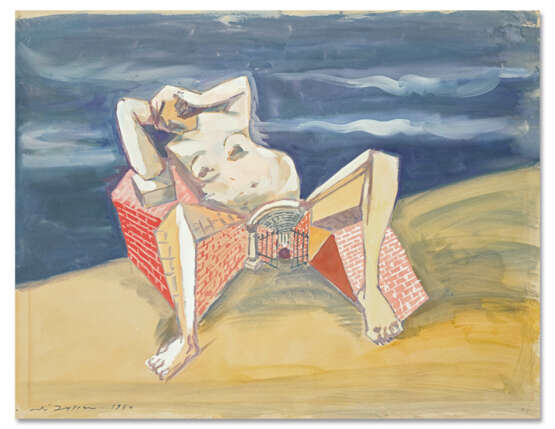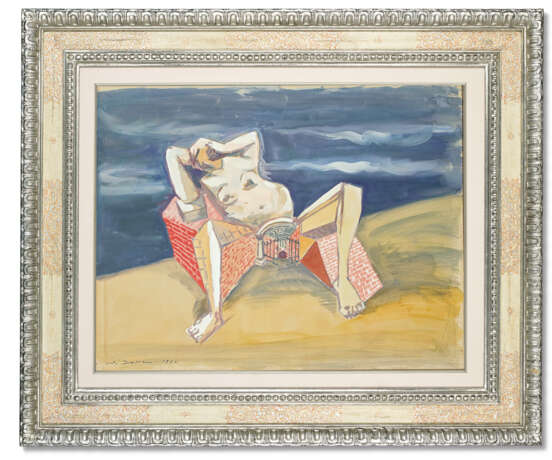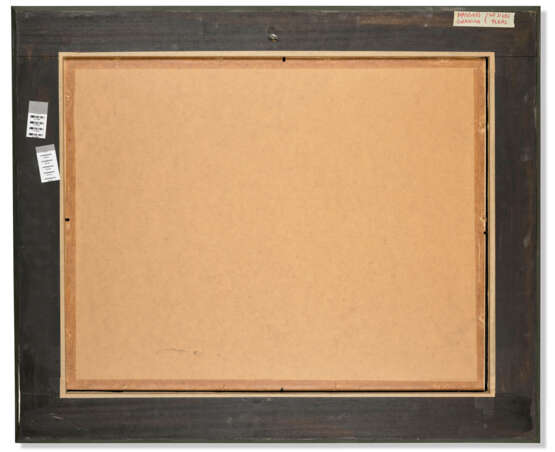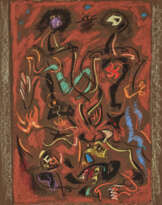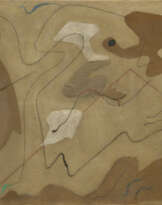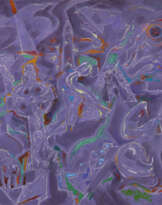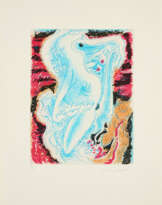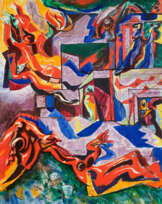ID 813859
Lot 16 | André Masson (1896-1987)
Estimate value
€ 80 000 – 120 000
Gradiva
signé et daté 'andré Masson. 1940' (en bas à gauche)
gouache sur papier
50.1 x 64.8 cm.
Réalisé en 1940
signed and dated 'andré Masson. 1940' (lower left)
gouache on paper
19 3/4 x 25 1/2 in.
Executed in 1940
Provenance
Galerie Louise Leiris, Paris
Acquis auprès de celle-ci en janvier 1987
Exhibited
Paris, Galerie Louise Leiris, André Masson, 90 œuvres sur papier, avril-mai 1986, No. 71 (illustré en couleurs au catalogue d'exposition p. 62).
Special notice
Artist's Resale Right ("droit de Suite").
If the Artist's Resale Right Regulations 2006 apply to this lot, the buyer also agrees to pay us an amount equal to the resale royalty provided for in those Regulations, and we undertake to the buyer to pay such amount to the artist's collection agent.
Post lot text
« Le Gradiva de Masson est peut-être la tentative la plus réussie des surréalistes de transformer une source littéraire en une déclaration mythologique sur la condition humaine. » - Whitney Chadwick
“Masson's Gradiva is perhaps the Surrealists' most successful attempt to transform a literary source into a mythological statement about the human condition.'' - Whitney Chadwick
Sujet majeur dans l’œuvre de l’artiste André Masson à la fin des années 1930, le thème de Gradiva fut également d’une importante fécondité au sein du mouvement surréaliste qui atteint alors son apogée. Masson, comme Dalí, Breton ou d’autres encore, s’inspire alors d’une nouvelle éponyme écrite en 1903 par Wilhelm Jensen et dont Sigmund Freud fit l'analyse dans un essai de 1906 (intitulé Le délire et les rêves dans la "Gradiva" de Jensen et publié en français en 1931, cette analyse demeure l’un des plus importants exemples d'interprétation psychanalytique d'une œuvre d'art). La nouvelle de Jensen narre l’amour que porte le héros principal, l’archéologue Norbert Hanold, à un bas-relief romain représentant une jeune femme, à la démarche d'une grâce singulière, qu'il nomme Gradiva, signifiant ‘celle qui avance’. Jean-Michel Goutier résume ainsi l’intrigue : « à la suite d'un rêve, Hanold, convaincu que Gradiva est morte à Pompéi en l'an 79 victime de l'éruption du Vésuve, décide de se rendre sur les lieux du drame. Il y croise une inconnue qu'il prend tout d'abord pour une apparition, puis pour la réincarnation de son idole et qui se trouve être, en réalité, une camarade d'enfance oubliée, Bertgang, traduction allemande de ‘celle qui s'avance’ ».
Il est indéniable que le grand lecteur qu'était Masson – qui affirme, dans une lettre à Michel Leiris, du 4 juillet 1938, avoir « beaucoup lu depuis deux semaines et pas de journaux ! Gradiva de Jensen » – s’inspirait de ses lectures pour composer ses tableaux et trouver des thèmes nouveaux qui devaient servir sa production surréaliste.
Dans la présente gouache, Masson reprend les principaux éléments du Surréalisme pour créer une composition fantastique et surprenante. L’artiste cherche alors à officialiser sa réconciliation définitive avec le groupe d'André Breton, avec qui il s’était brouillé en 1929. C’est également l’occasion pour lui de livrer un véritable manifeste de sa seconde période surréaliste, qui se poursuivra jusqu'en 1942. A la fin des années 1930, face à la montée du fascisme qui menace l'Europe, les liens entre Masson, tout juste rentré d’Espagne, et les artistes surréalistes se renforcent et les coopérations artistiques se multiplient.
Bouleversé par la Première Guerre Mondiale et plus particulièrement par la balle qui l’avait blessé à la poitrine et qui lui avait valu d’être laissé pour mort pendant une nuit, Masson développe un intérêt particulier pour la mort. Cet intérêt aura un impact indéniable sur son œuvre et sa perception du monde. Dans la présente gouache, la figure centrale, à demi pétrifiée et à demi défigurée, semble à la fois morte et vivante. Le surréalisme devient alors un moyen pour André Masson de dépeindre les extrêmes : la vie et la mort, la chair et la pierre. Il nous livre alors une véritable expérience visuelle et sensuelle, laissant voir des formes peintes à partir de son inconscient.
En plus d’être un sujet surréaliste par excellence, Gradiva de Masson témoigne donc d’une véritable tension entre la vie et la mort ainsi que d’une fascination de l’artiste pour l’inconscient.
Gradiva was a major theme in artist André Masson’s work in the late 1930s, and was also a very fertile subject in the Surrealist movement, then at its height. Like Dalí, Breton and others, Masson was inspired by the eponymous novel written in 1903 by Wilhelm Jensen, which Sigmund Freud analysed in a 1906 essay (entitled Délire et rêves dans la "Gradiva" de Jensen, first translated into English in 1917, this analysis remains one of the most important examples of psychoanalytical interpretation of a work of art). Jensen’s story is about the love of the protagonist, archaeologist Norbert Hanold, for a Roman bas-relief of a young woman with a uniquely graceful gait, whom he calls Gradiva, meaning “She who goes forward”. Jean-Michel Goutier summarised the plot as follows: “Following a dream, Hanold, convinced that Gradiva died in Pompeii in 79 AD as a result of the eruption of Mount Vesuvius, decides to travel to the scene of the tragedy. There, he meets a unknown woman whom he initially mistakes for an apparition, then for the reincarnation of his idol who actually turns out to be a forgotten childhood friend, Bertgang, German for ‘she who goes forward’.”
It is beyond dispute that Masson, an avid reader – who, in a letter to Michel Leiris dated 4 July 1938, stated that he had “read a lot in the last two weeks and not newspapers! Jensen’s Gradiva” – was inspired by his readings to compose his paintings and find new themes that would serve his Surrealist production.
In this gouache, Masson uses the main elements of Surrealism to create a surprising and fantastical composition. The artist then sought to formalise his ultimate reconciliation with André Breton’s group, with whom he had fallen out in 1929. It was also an opportunity for him to present a genuine manifesto of his second surrealist period, which would continue until 1942. By the end of the 1930s, with the rise of fascism threatening Europe, Masson, who had just returned from Spain, became more closely linked to the Surrealist artists and their artistic cooperation increased.
Deeply affected by World War I, in particular by the bullet that struck him in the chest leaving him for dead overnight, Masson developed a marked interest in death. This interest would have an undeniable impact on his work and his perception of the world. In this gouache, the central figure, half petrified and half disfigured, seems both dead and alive. Surrealism then became a means for Masson to depict extremes: life and death, flesh and stone. He thus delivers a true visual and sensual experience, letting us see forms painted from his unconscious.
In addition to being a quintessential Surrealist subject, Masson’s Gradiva thus testifies to a genuine tension between life and death, and to the artist’s fascination with the unconscious.
| Artist: | André Masson (1896 - 1987) |
|---|---|
| Applied technique: | Gouache |
| Artist: | André Masson (1896 - 1987) |
|---|---|
| Applied technique: | Gouache |
| Address of auction |
CHRISTIE'S 9 Avenue Matignon 75008 Paris France | ||||||||||||||
|---|---|---|---|---|---|---|---|---|---|---|---|---|---|---|---|
| Preview |
| ||||||||||||||
| Phone | +33 (0)1 40 76 85 85 | ||||||||||||||
| Fax | +33 (0)1 40 76 85 86 | ||||||||||||||
| Conditions of purchase | Conditions of purchase | ||||||||||||||
| Shipping |
Postal service Courier service pickup by yourself | ||||||||||||||
| Payment methods |
Wire Transfer | ||||||||||||||
| Business hours | Business hours
|
